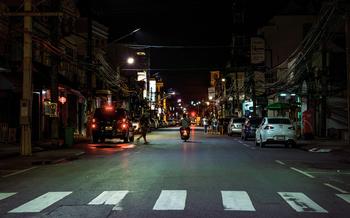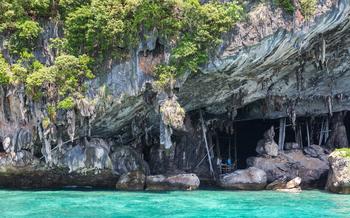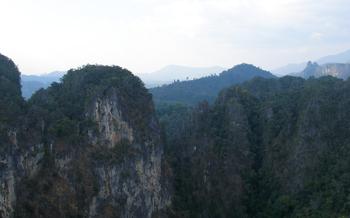
Kapoe Estuary
- Kapoe Estuary: A Hidden Gem of Ranong
- Getting There: A Journey to the Estuary
- Exploring the Estuary: A Paradise for Nature Lovers
- Kayaking through the Mangroves: A Serene Adventure
- Birdwatching Haven: Spotting Rare and Beautiful Species
- Hiking Trails: Unveiling the Estuary's Secrets
- A Glimpse into Local Life: Fishing Communities
- Cultural Heritage: Unveiling Ranong's Past
- Photography Paradise: Capturing Nature's Beauty
- Accommodation Options: Nesting Near Nature
- Responsible Tourism: Treading Lightly
- Safety Precautions: Ensuring a Safe Journey
- Insider Tip: Unveiling a Hidden Gem
Kapoe Estuary: A Hidden Gem of Ranong
Nestled in the heart of Ranong province, Thailand, lies a hidden gem waiting to be explored - the Kapoe Estuary. This natural wonder is a haven for nature enthusiasts, offering a diverse ecosystem, rich biodiversity, and a chance to witness the beauty of unspoiled landscapes. The estuary is formed by the convergence of the Kapoe River with the Andaman Sea, creating a unique habitat that supports a remarkable array of flora and fauna. Declared a Ramsar Site, a wetland of international importance, the Kapoe Estuary is recognized for its ecological significance and the need for its conservation. As you embark on a journey to this hidden gem, be prepared to be captivated by the enchanting beauty and tranquility that await you.
Getting There: A Journey to the Estuary
Reaching the Kapoe Estuary from Ranong town is a straightforward journey that can be undertaken independently or with the assistance of a guided tour. For those who prefer to explore at their own pace, the estuary is accessible by car or motorbike, with clear signage guiding visitors along the way. The drive takes approximately 45 minutes, offering scenic views of the surrounding countryside. Alternatively, guided tours are available from local operators, providing a convenient and informative option for those who wish to learn more about the estuary's unique ecosystem and history. When planning your visit, consider the weather conditions, as the best time to explore the estuary is during the dry season (November to April) when the skies are clear, and the humidity is low.
Exploring the Estuary: A Paradise for Nature Lovers
The Kapoe Estuary is a haven for nature enthusiasts, offering a diverse range of activities that allow visitors to immerse themselves in the beauty of this natural wonderland. Kayaking, birdwatching, and hiking are just a few of the ways to explore the estuary's intricate waterways, diverse habitats, and rich wildlife.
Kayaking through the mangrove forests offers a serene and intimate experience, allowing you to glide silently through the tranquil waters and observe the incredible biodiversity that thrives in this unique ecosystem. Birdwatching enthusiasts will be delighted by the estuary's status as a haven for over 200 bird species, including migratory birds and resident species that can be spotted in their natural habitat.
For those who prefer to explore on foot, the Kapoe Estuary offers a network of hiking trails that wind through its diverse habitats, leading to hidden corners, secret waterfalls, and panoramic viewpoints. These trails provide an opportunity to discover the estuary's hidden treasures, from lush mangrove forests to sparkling streams, and offer a chance to learn about the local flora and fauna from experienced guides.
Kayaking through the Mangroves: A Serene Adventure
Glide through the tranquil waters of the Kapoe Estuary on a kayaking adventure that unveils the mesmerizing beauty of the mangrove forests. Immerse yourself in the serene atmosphere as you paddle along the intricate waterways, surrounded by towering mangroves that create a natural canopy above. The gentle lapping of the water against your kayak and the chirping of birds in the distance create a symphony of sounds that soothe the soul.
Kayaking in the estuary offers a unique perspective, allowing you to explore hidden corners and discover the incredible biodiversity that thrives within this ecosystem. Spot playful otters frolicking in the water, monitor lizards basking in the sun, and a variety of bird species soaring overhead. With a little luck, you might even encounter the elusive dugong, a gentle marine mammal that frequents the estuary's waters.
Remember to embrace the serenity of the moment and paddle mindfully, respecting the fragile ecosystem that surrounds you. Avoid disturbing the wildlife and leave no trace of your presence. Embrace the opportunity to connect with nature on a deeper level as you glide through the mangroves, creating memories that will last a lifetime.
Birdwatching Haven: Spotting Rare and Beautiful Species
The Kapoe Estuary is a paradise for bird enthusiasts, boasting over 200 recorded species that call this diverse ecosystem home. As you glide through the tranquil waters or hike along the winding trails, keep your eyes peeled for a dazzling array of feathered friends. Spot migratory birds, such as the majestic brahminy kite or the colorful oriental darter, as they grace the skies. Resident species, like the white-throated kingfisher and the mangrove pitta, add to the estuary's avian symphony with their melodious calls.
To enhance your birdwatching experience, consider joining a guided tour led by knowledgeable local guides who can help you identify different species and share fascinating insights into their behavior and habitats. With a bit of patience and luck, you may even catch a glimpse of the elusive hornbill or the shy blue-eared kingfisher, making your visit to the Kapoe Estuary a truly unforgettable ornithological adventure.
Hiking Trails: Unveiling the Estuary's Secrets
The Kapoe Estuary boasts a network of well-maintained hiking trails that wind through its diverse habitats, offering an opportunity to explore hidden corners and discover the estuary's best-kept secrets. These trails range from easy walks suitable for families with young children to more challenging treks for experienced hikers, ensuring that there is something for everyone.
As you embark on your hike, you will encounter a variety of landscapes, from lush mangrove forests to towering limestone cliffs and secluded beaches. Keep an eye out for hidden waterfalls, where you can take a refreshing dip and enjoy the tranquil surroundings. The trails also lead to panoramic viewpoints that offer breathtaking vistas of the estuary and the surrounding countryside.
Remember to follow designated trails and avoid venturing off the beaten path. This helps to minimize your impact on the environment and ensures that you do not disturb the delicate ecosystem. By staying on the trails, you can also avoid getting lost or encountering any unexpected hazards.
A Glimpse into Local Life: Fishing Communities
Within the serene embrace of the Kapoe Estuary, traditional fishing communities have flourished for generations, their lives intricately woven with the rhythms of the sea. As you venture into the estuary, you'll encounter these communities, where time seems to stand still, and the essence of a simpler way of life lingers in the air.
Engage with the local fishermen, whose weathered faces bear the tales of countless voyages. Listen to their stories of triumphs and challenges, as they share the secrets of their craft, passed down through generations. Learn about their traditional fishing techniques, honed over decades of experience, and witness the harmony between humans and nature that defines their existence.
Indulge in the freshest catch of the day, prepared with love and expertise by local hands. Savor the flavors of the sea, as you support sustainable fishing practices that ensure the long-term health of the estuary's ecosystem. Your visit to the Kapoe Estuary offers a unique opportunity to connect with the local way of life, appreciate the resilience of these communities, and gain a deeper understanding of the delicate balance between humanity and the natural world.
Cultural Heritage: Unveiling Ranong's Past
The Kapoe Estuary holds significant historical importance as a trading route and fishing ground. Its strategic location along the Andaman Sea has attracted people from various cultures and civilizations throughout history. Evidence of these past influences can be found in the remnants of ancient settlements, artifacts, and cultural practices that have been passed down through generations.
Exploring the estuary offers a glimpse into Ranong's rich cultural heritage. Visitors can discover ancient ruins, such as the remnants of a Portuguese fort, which speak to the region's role in maritime trade. The area is also home to several temples and shrines that showcase the unique blend of Buddhist and animist beliefs that have shaped Ranong's cultural identity.
Preserving and celebrating this cultural heritage is vital for maintaining a sense of identity and fostering a connection with the past. Local communities play a crucial role in safeguarding traditions, promoting cultural events, and passing on knowledge to future generations. Visitors can contribute to these efforts by showing respect for local customs, supporting traditional arts and crafts, and engaging with the community in a meaningful way.
Photography Paradise: Capturing Nature's Beauty
The Kapoe Estuary is a photographer's paradise, offering a stunning array of landscapes and wildlife that will leave you in awe. The vibrant colors of the mangroves, the serene reflections of the water, and the diverse array of birds and animals provide endless opportunities to capture breathtaking shots.
Whether you're a seasoned professional or simply enjoy taking snapshots, the Kapoe Estuary has something for everyone. The diverse habitats and unique perspectives ensure that you'll find plenty of opportunities to capture unique and memorable images.
To make the most of your photography experience, consider using a camera with a wide-angle lens to capture the vastness of the estuary. A telephoto lens will allow you to zoom in on distant wildlife and capture intimate portraits. Remember to bring a tripod to stabilize your camera for sharp and steady shots.
As you explore the estuary, keep an eye out for the many photogenic moments that await you. The sunrise and sunset are particularly magical times, casting a warm glow over the landscape and creating stunning silhouettes. The reflections of the mangroves in the water provide a unique opportunity for creative compositions.
Don't forget to share your photographs with the world and inspire others to explore this hidden gem. Tag your photos on social media using relevant hashtags and share your experiences with fellow travelers. Your images can help raise awareness about the importance of preserving this natural wonder and encourage others to visit and appreciate its beauty.
Accommodation Options: Nesting Near Nature
When planning your stay in Ranong, you'll find a diverse range of accommodation options to suit every budget and preference. From budget-friendly guesthouses to luxurious resorts, there's something for every traveler.
For a truly immersive experience, consider staying in an eco-friendly accommodation that embraces sustainable practices. These accommodations often use renewable energy sources, incorporate recycled materials into their design, and support local conservation efforts. By choosing an eco-friendly accommodation, you can help minimize your impact on the environment and contribute to the preservation of this natural wonder.
When selecting your accommodation, consider the following factors:
- Location: Choose an accommodation that is conveniently located for exploring the Kapoe Estuary and other attractions in Ranong.
- Amenities: Consider the amenities that are important to you, such as air conditioning, Wi-Fi, and a swimming pool.
- Budget: Set a budget for your accommodation and stick to it. There are plenty of affordable options available without compromising on comfort.
- Reviews: Read reviews from previous guests to get an idea of the quality of the accommodation and the level of service you can expect.
Whether you're looking for a simple place to rest your head or a luxurious retreat, you'll find the perfect accommodation in Ranong to complement your exploration of the Kapoe Estuary.
Responsible Tourism: Treading Lightly
As you embark on your journey to the Kapoe Estuary, it is crucial to embrace responsible tourism practices to minimize your impact on this pristine natural wonder. Start by leaving no trace, packing all your waste and recycling or disposing of it properly. Respect the local culture and customs, dressing appropriately and seeking permission before entering private property or taking photographs of people. Support sustainable businesses that prioritize conservation and give back to the community. By choosing eco-friendly accommodation, dining options, and tour operators, you can contribute to the long-term preservation of this unique ecosystem. Remember, responsible tourism is about creating a positive impact, leaving a legacy of care and respect for generations to come. So, tread lightly, embrace sustainability, and become an advocate for the Kapoe Estuary's conservation.
Safety Precautions: Ensuring a Safe Journey
Venturing into the natural wonders of the Kapoe Estuary requires a mindful approach to safety. While the estuary is generally a serene and welcoming environment, it's essential to be aware of potential risks and take necessary precautions.
Begin by dressing appropriately for the adventure. Opt for comfortable clothing that allows freedom of movement and sturdy footwear with good grip to navigate uneven terrain. The estuary's humid climate calls for lightweight, breathable fabrics to keep you cool and comfortable.
Be mindful of the slippery surfaces that may arise due to moisture or fallen leaves. Walk cautiously on trails and boardwalks, especially during or after rainfall. Mangrove roots can be uneven and slippery, so exercise caution when exploring these areas.
Wildlife encounters are a highlight of the Kapoe Estuary experience, but it's crucial to maintain a respectful distance from all animals. Avoid touching or disturbing wildlife, and never attempt to feed them. Observe them from a safe distance and admire their natural behaviors without disrupting their habitat.
It's advisable to be aware of the weather conditions before embarking on your journey. While the estuary is generally calm and sheltered, sudden weather changes can occur, especially during the monsoon season. Check the local weather forecast and be prepared with appropriate gear, such as raincoats or umbrellas.
Emergency services and medical facilities are available in Ranong town, a short distance from the estuary. However, it's always advisable to carry a basic first-aid kit for minor injuries or ailments. If you have any specific medical conditions or concerns, consult with your healthcare provider before your trip.
By following these safety precautions and exercising common sense, you can ensure a safe and enjoyable exploration of the Kapoe Estuary, creating lasting memories in this natural paradise.
Insider Tip: Unveiling a Hidden Gem
Beyond the well-trodden paths of the Kapoe Estuary lies a hidden gem that will captivate the hearts of nature enthusiasts. Tucked away in a secluded corner, this secret spot offers breathtaking views of the estuary's pristine beauty. Imagine standing on a secluded beach, the soft sand beneath your feet and the gentle sound of waves lapping against the shore. As you gaze across the glistening waters, the lush mangrove forests stretch out before you, creating a verdant tapestry that seems to melt into the horizon.
The best time to visit this hidden gem is during the early morning hours when the air is still and the light is soft and golden. As the sun casts its warm glow across the landscape, the estuary comes alive with a symphony of sounds. Birdsong fills the air as they flit among the mangroves, and the gentle splash of fish leaping from the water adds to the harmonious chorus.
This secret spot is a sanctuary for wildlife, and with a keen eye, you may spot shy animals that rarely venture into the more popular areas of the estuary. Keep an eye out for monitor lizards basking in the sun, or perhaps catch a glimpse of a majestic eagle soaring overhead. The estuary's mangroves are also home to a variety of crabs and mollusks, adding to the rich biodiversity of this unique ecosystem.
It's important to remember that this hidden gem is a fragile environment, and it's essential to tread lightly and leave no trace. Respect the wildlife and their habitat, and always follow the principles of responsible tourism. By doing so, you'll help preserve this special place for future generations to enjoy.






